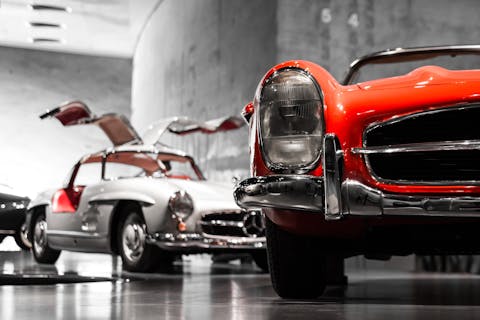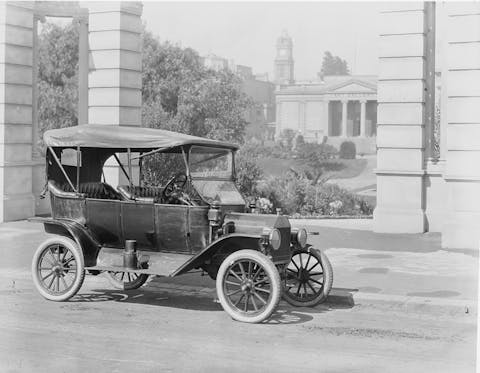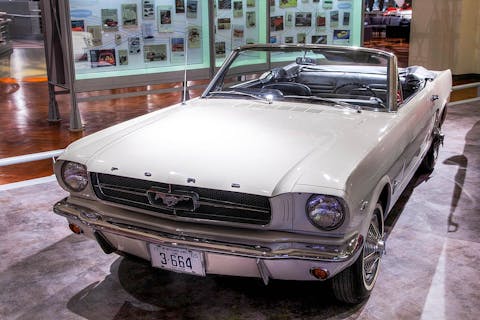How to Value Classic Cars
Since the first ever gasoline-powered automobile was manufactured in 1886, cars have been a subject of intrigue and fascination for generations. It is no wonder that today collecting classic cars is such a popular hobby amongst enthusiasts, with a world and culture of its very own.
Teal car parked in front of two buildings. Image: Public Domain
Just as in the case with fine art, classic car collectors focus on different styles and eras when developing their collection. However it can be difficult to navigate this world and what rules govern how a car is valued. Whether you are looking to buy, sell, or simply learn more about classic cars, the following guidelines should be helpful in beginning your pursuit.
Start your classic car valuation here!
What is a classic car?
First and foremost, it is important to define what exactly qualifies as a classic car. In fact there are a few terminologies to consider when assessing a car’s worth. A classic car refers to one that is twenty years old at youngest, and forty years at oldest. Vintage cars, though opinions vary slightly according to certain groups, generally date from 1919 to 1930. Antique cars are typically over at least 45 years old, though this also can vary according to state law. These terms can overlap with each other, as all classic cars are not antique cars but not all antique cars are classic. It is important to establish which category your car falls into in order as this is the base criteria for beginning to draw an estimate of its value.
Related: Classic Cars And The New Collectors
"A classic car refers to one that is twenty years old at youngest, and forty years at oldest."

Classic Mercedes cars in a gallery. Image Public Domain
Eras in Cars
Researching the history of your car is also invaluable in determining its worth. It is crucial to attempt to learn more about a specific car’s history, since often time if a car has an interesting backstory or provenance, it can significantly add to its value. A good place to start when beginning this journey is to learn more about its era. The manufacture of cars can be split into multiple definitive eras that one can easily assess and recognize if proper research is done.
The Veteran Era
The Veteran Era, dating from 1885-1905, included the first ever successfully operating automobiles. They were powered either by gas, electricity, or steam, and took months to create. As the science of car manufacturing had yet to be perfected, they often broke down and had other mechanical issues, although the age and rarety of such models alone are enough to render them as significant collectibles.
The Brass Era
The Brass Era, referring to the brass parts found in cars of this time, dates between 1906 and the end of World War I. With iconic models such as the Ford T Model, and the enabling of improved car manufacturing brought on upon by assembly lines, car manufacturing took a drastic turn, moving from a luxury afforded only by the wealthy, to the world’s main means of transportation.

Model-T Ford car parked near the Geelong Art Gallery at its launch in Australia in 1915. Image: Public Domain
"It goes without saying that a working car in excellent condition will be worth insurmountably more than a car with missing parts or that is otherwise rendered unable to function."
The Vintage Era
This era encompasses the period between World War I and the Great Depression, and marked a shift towards comfort over style, with enclosed areas for passengers. Models from this time also feature more powerful engines, and the Ford T Model reduced in price from £649 in 1909 to £235 in 1925.
Pre World-War II Era
This era describes the period between 1929-1948. Most of the technology we recognize today was invented and introduced during this time, such as enclosed bodies, trunks, radiation, integrated fenders, and unified lights. In 2017, a 1948 Cadillac Series 62 Cabriolet by Saoutchik produced during this era sold for £695,000 at auction.
Post War Era
The Post War Era occurred between 1948 and 1972, and cars became both more powerful and more decorative as the middle class grew and troops returning for war were ready to purchase. Ford unveiled the Mustang at the 1964 World Fair, and the term ‘muscle cars’ was coined for the first time.

"1964½" Mustang convertible serial No. 1. Photo: Alvintrusty / License: CC BY-SA 3.0
Price Guides
There are various online resources available that provide rough estimates for the value of a specific make or model. While these ought not to be taken at face value, they can be very helpful in providing general insight into what you can expect to pay, or make. It is important to compare prices from different sources so as to average out the most realistically accurate estimate. A few of such price guides available are The National Automobile Dealers Association, Hagerty Insurance, Hemmings, and HAGI Index.
Related: 10 Most Expensive Classic Cars Ever Sold at Auction
Key Appraisal Factors
As with any other collectible or work of art, a number of different factors play into how it is valued. Market demand, rarety, quality of restoration, and condition are all elements that greatly affect the worth of a car. It goes without saying that a working car in excellent condition will be worth insurmountably more than a car with missing parts or that is otherwise rendered unable to function. However if a car does meet all of these criteria, the results can be staggering. For example in 2019, a 1962 Ferrari 250 GTO sold for £40 million at auction.
However, ultimately a truly accurate estimate can only be made by an expert in the field, so perhaps the most crucial part of the process is to have your car professionally appraised. Luckily Value My Stuff provides access to professional valuation services at your fingertips so you can have your classic car valued today!

